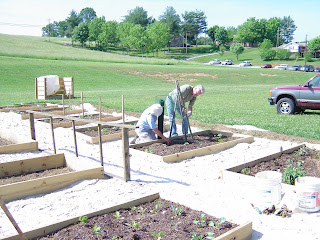We have received many donations of plants and have begun planting them in be beds. A primary goal of raised bed gardening is to maxamize production by planting items close together and going UP instead of out. Brian and Marcia are constructing a tower for cucumber plants. Note the silica sand between the rows. The sand was leftover from the New Horizons Garden in Kingsport. This is another major goal of raised beds-- Minimize the weeding chores through mulching. We used the sand as a way to mulch, but also to reduce costs. The Community Clothes Closed had approved funding for the addition of manufactured dolomite sand, but we decided that the sand would suffice for the current year. In a year of difficult times for many in our community, we thought the funds would be better spent addressing other community projects.
This is one of the planted boxes. We used some partially composted leaves as a mulch and have pounded stakes for the plants to begin their upward growth. We had some donated stakes but also used the treated spacers from the lumber. They were ripped to managable dimensions and had a point cut at one end for ease in insertion. We used every scrap.
The second donation from the Community Closet was used to purchase wire for the tomato cages, and lumber to build a second compost bin.
We also received a donation of some plastic coated wire that was 4' tall. This is a garden experiment to see how the material will hold up to the weight of the cucumbers in this tower. Six cucs were planted around the circumference of the tower.
The Second of our Master Gardener Mentors is Judy Penley. She is preparing a large bed for planting. We were limited by the lack of compost this year and have actually trenched some of the boxes to make the soil for inside of the bed. More on the Sand for Compost Arrangement later. Judy is one of the major exhibitors at the Appalachian Fair. Hopefully her expertise in raising the huge, weird, wonderful and Prize Winners will rub off on the garden .
Here is a excellent example of the UP not out concept of raised bed gardens. The tomato cages were constructed from a 6' length of the welded garden wire. One end is cut flush and the other end has the horizontal wires left to complete the circle. We used reinforcing wire stakes with a small barb. This was pounded into the ground to provide additional support for the growing tomatoes. We also cut openings into the wire to facilitate the removal of the soon to appear tomatoes. We used the wooden stakes and plastic wire to form a support for the yellow summer squash in the same bed.
Water is becoming an issue of some great importance for the garden. We have been hauling water for the transplanting. In the left rear of the photo is the water tank. Capacity is almost 350 gallons. It does, however, lack an outside cage for support. When first filled, it was like a water balloon and oozed off the pallet. We are reworking the concept by placing the tank inside the compost bin. Plan B says use nylon ropes to anchor the tank to the structure of the bin. We purchased a rain gauge for the garden. It has unfortunately seen very little use. Since this picture, we did receive about 1/3" of rain. In the lower left is a former grape arbor top. It is going to be recycled into a support for climbing beans.
In a lesson on Compare and Contrast we planted some items in the area of the garden that did not have raised beds. One of the local farmers came and tilled over the surface to kill some of the sprouting weeds. We will place cardboard over the rows for weed control. In the "Flat Lands" we erected a 12' length of plastic wire as support for a row of half runner beans. Some recycled bamboo poles were used to form a triangular support for Missouri Pole Beans. And we planted a row of tall sunflower seeds.
We decided it was important to include flowers and herbs in the garden. Marcia and Judy have donated some perennials. We placed these so they would be closest to the road so it would present a good appearance to passing drivers and walkers.
Organic Weed and Pest Control
The flea beetles are starting to skeletonize the eggplants. Used soapy water to spray. We also used a spray of straight vinegar to zap some of the emerging Bermuda grass. A dilute spray of skim milk and water can be used for control of bean bugs. Works fine, but do not try to save in the Hot summer weather (remember the baby bottles). Ditch after use.







No comments:
Post a Comment